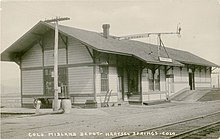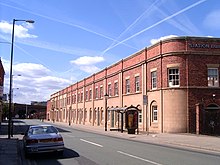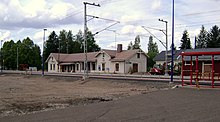
Central is a heritage-listed railway station located in the centre of Sydney, New South Wales, Australia. The station is Australia's largest and second busiest railway station, and is a major transport interchange for NSW TrainLink inter-city rail services, Sydney Trains commuter rail services, Sydney light rail services, bus services, and private coach transport services. The station is also known as Sydney Terminal. The property was added to the New South Wales State Heritage Register on 2 April 1999. It recorded 85.4 million passenger movements in 2018 and serves over 250,000 people daily.

Chicago Union Station is an intercity and commuter rail terminal located in the West Loop neighborhood of the Near West Side of Chicago. Amtrak's flagship station in the Midwest, Union Station is the terminus of eight national long-distance routes and eight regional corridor routes. Six Metra commuter lines also terminate here.

Portland Union Station is a train station in Portland, Oregon, United States, situated near the western shore of the Willamette River in Old Town Chinatown. It serves as an intermediate stop for Amtrak's Cascades and Coast Starlight routes and, along with King Street Station in Seattle, is one of two western termini of the Empire Builder. The station is a major transport hub for the Portland metropolitan area with connections to MAX Light Rail, the Portland Streetcar, and local and intercity bus services. The station building contains Wilf's Restaurant & Bar on the ground level and offices on the upper floors. It also has Amtrak's first Metropolitan Lounge on the West Coast, which is reserved for first-class sleeping car and business-class passengers.

The Richard B. Ogilvie Transportation Center, on the site of the former Chicago and North Western Terminal, is a commuter rail terminal in downtown Chicago, Illinois. For the last century, this site has served as the primary terminal for the Chicago and North Western Railway and its successors Union Pacific and Metra. Intercity services had disappeared by the 1970s, but commuter services on the three ex-CNW mainlines, Metra's UP District lines, continue to terminate here. The tracks are elevated above street level. The old CNW terminal building was replaced in the mid 1980s with a modern skyscraper, the 500 West Madison Street building. The modern building occupies two square city blocks, bounded by Randolph Street and Madison Street to the north and south and by Canal Street and Clinton Street to the east and west. It is the second busiest rail station in Chicago, after nearby Union Station, the sixth-busiest railway station in North America, and the third-busiest station that exclusively serves commuter traffic.

Cincinnati Union Terminal is an intercity train station and museum center in the Queensgate neighborhood of Cincinnati, Ohio. Commonly abbreviated as CUT, or by its Amtrak station code, CIN, the terminal is served by Amtrak's Cardinal line, passing through Cincinnati three times weekly. The building's largest tenant is the Cincinnati Museum Center, comprising the Cincinnati History Museum, the Museum of Natural History & Science, Duke Energy Children's Museum, the Cincinnati History Library and Archives, and an Omnimax theater.

St Marys railway station is a heritage-listed former goods yard, railway signal box and now railway station located on the Main Western line in the western Sydney suburb of St Marys in the City of Penrith local government area of New South Wales, Australia. The station is served by Sydney Trains T1 Western line services. The station marks the end of the four-track section of the Main Western line. It was designed by New South Wales Government Railways and was built in 1862. It is also known as St. Marys Railway Station Group and St Marys Railway Station. The property was added to the New South Wales State Heritage Register on 2 April 1999.
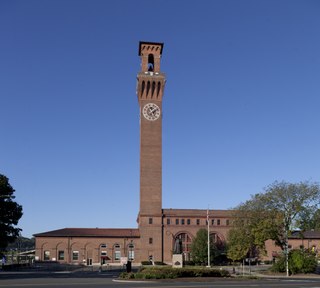
The Waterbury Union Station building is located on Meadow Street in the city of Waterbury, Connecticut, United States. It is a brick building dating to the first decade of the 20th century. Its tall clock tower, built by the Seth Thomas Company, is the city's most prominent landmark.

Lithgow railway station is a heritage-listed former station master's residence and railway station located on the Main Western line at Railway Parade, Lithgow, City of Lithgow, New South Wales, Australia. It was designed and built by New South Wales Government Railways and built from 1924 to 1925. It is also known as Lithgow Railway Station Group and Residence and Eskbank East. The property was added to the New South Wales State Heritage Register on 30 August 2013. The station has frequent NSW TrainLink services running to and from Sydney Central.
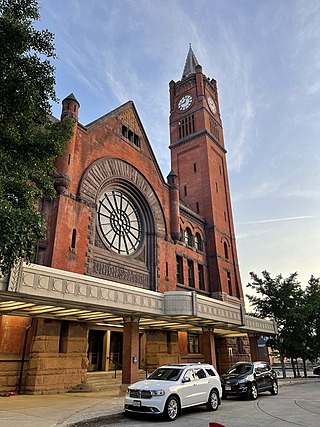
The Indianapolis Union Station is an intercity train station in the Wholesale District of Indianapolis, Indiana. Currently, Amtrak's Cardinal line serves the terminal, passing through Indianapolis three times a week.

Essen Hauptbahnhof is a railway station in the city of Essen in western Germany. It is situated south of the old town centre, next to the A 40 motorway. It was opened in 1862 by the Bergisch-Märkische Eisenbahn. However, the station was not the first in Essen: as the station called Essen on the Köln-Mindener Eisenbahn was opened in 1847.

Moscow Yaroslavsky railway station is one of the nine main railway stations in Moscow. Situated on Komsomolskaya Square, Moscow Yaroslavskaya has the highest passenger throughput of all nine of the capital's main-line terminuses. It serves eastern destinations, including those in the Russian Far East, being the western terminus of the world's longest railway line, the Trans-Siberian. The station takes its name from that of the ancient city of Yaroslavl which, lying 284 rail kilometres north-east of Moscow, is the first large city served by the line.

The Chicago, Milwaukee, St. Paul and Pacific Depot Freight House and Train Shed, now officially named The Depot, is a historic railroad depot in downtown Minneapolis, Minnesota, United States. At its peak, the station served 29 trains per day. Following decline, the station was closed and eventually adapted into various other uses.

Junee railway station is a heritage-listed railway station located on the Main Southern line in New South Wales, Australia. It serves the town of Junee in the Junee Shire. It was added to the New South Wales State Heritage Register on 2 April 1999.

A train station, railroad station, or railroad depot and railway station is a railway facility where trains stop to load or unload passengers, freight, or both. It generally consists of at least one platform, one track, and a station building providing such ancillary services as ticket sales, waiting rooms, and baggage/freight service. Stations on a single-track line often have a passing loop to accommodate trains travelling in opposite direction.

Croton North station is a disused train station on Senasqua Road in Croton-on-Hudson, New York, United States. It was built by the New York Central Railroad in the late 19th century. In 1987 it was listed on the National Register of Historic Places as Croton North Railroad Station.

Pavia railway station serves the city and comune of Pavia, in the region of Lombardy, northern Italy. Opened in 1862, it forms part of the Genoa–Milan railway, and is also a terminus of four secondary railways, linking Pavia with Alessandria, Mantua, Vercelli and Stradella.

Macerata railway station serves the city and comune of Macerata, in the region of Marche, central Italy. Opened in 1886, it forms part of the Civitanova–Fabriano railway.

Toowoomba railway station is a heritage-listed railway station on the Western line at Russell Street, Toowoomba, Toowoomba Region, Queensland, Australia. It serves the city of Toowoomba, which is the junction for the Western, Main and Southern lines. The station has one platform with a passing loop, opening in 1867. It was designed by FDG Stanley and built in 1873 by R. Godsall. It was added to the Queensland Heritage Register on 21 October 1992.

Charleville railway station is a heritage-listed railway station on the Western line at King Street, Charleville, Shire of Murweh, Queensland, Australia. It was built from 1888 to 1957. It was added to the Queensland Heritage Register on 12 July 2005.

The Toledo and Ohio Central Railroad Station, today named Station 67, is a union meeting space and event hall located in Franklinton, near Downtown Columbus, Ohio. Built by the Toledo and Ohio Central Railroad from 1895 to 1896, it served as a passenger station until 1930. It served as an office and shelter for Volunteers of America from 1931 to 2003, and has been the headquarters of International Association of Fire Fighters Local 67, a firefighters' union, since 2007. The building was placed on the National Register of Historic Places in 1973. During its history, the building has experienced fires and floods, though its relatively few owners have each made repairs and renovations to preserve the building's integrity. The building is the last remaining train station in Columbus.
